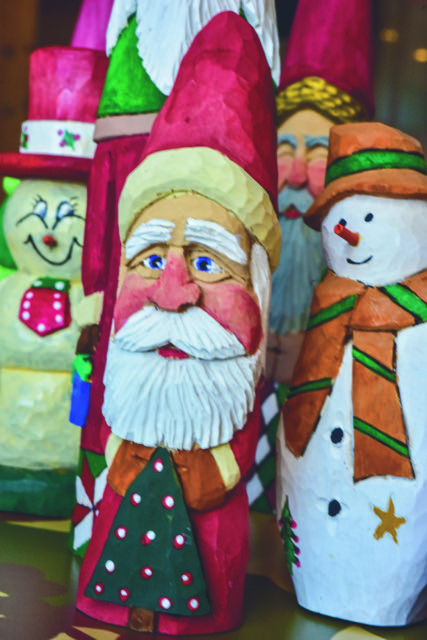

Maurice Vanhook is well known for his carved Santa Clauses.
Maurice Vanhook’s interest in wood carving started with inspiration in the ‘60s but didn’t come to fruition until more than 40 years later.
“For as long as I can remember, I have always had a desire to make things out of wood. I was inspired by a hand carved totem pole at a recreation area near my home in the early ‘60s. But life goes on and takes other paths. For 40-plus years I rode and trained horses, and I thought that is what I would do when I retired. But once I retired from my job and started to ride every day, I found out I was 40 years too late. So, I sold my horses, truck, trailer and tack and took my first class in woodcraft in Boones Creek, Tennessee.
“I love wood; the feel, the smell, the sound a very sharp knife makes as it slices through the wood. The satisfaction of a finished carving and a customer purchasing the item that may very well remain in the same family for years. I am inspired by the world around me. I look at people’s faces, the details, the wrinkles and their eyes,” Vanhook says.
While he is well known for his carved Santa Clauses, he’s also passionate about other subjects. His first carving was a wooden sword that he carved for a book report presentation in the ninth grade, which he still has.
“I love carving caricatures of cowboys, Native Americans and things or people in life around me. I also carve animals, especially dogs, and realistic bust carvings of mountain men, Indians, firemen and humans,” he says.
Woodworking requires sharp tools. He uses knives, hand and maul gouges and power tools depending on the project and the woods used in the project. To enhance his skills, he carves with other woodcarvers, attends classes taught by masters of their art and practices.
“I find wood to be a very forgiving medium, I mean, if you make a missed cut just go deeper into the carving.
“I have carved many different varieties of wood: cedar, buckeye, empress wood, butternut and fence post. My favorites are bass wood both the northern and southern types and cottonwood bark. The grain in bass wood is straight, and it holds detail very nice. Cottonwood bark is just that - the bark of a tree. It is very easy to carve and although it is soft and brittle, it will hold detail. In bass wood I usually have an idea or picture of what I am about to carve. With bark I let the wood lead me in what I am carving. By that I mean the wood may bend or turn a certain way and inspire me to put a feather there. Often, I will come across a piece of wood on the ground that just looks like something or I can see a dragon in it.
“Many times at a show I have folks pick up one of my creations and will say ‘$50 - Well I can get a Santa at Xmart for $1.” But is that item hand carved and hand painted, made from a block of wood that the carver has put his heart and soul into to make a piece that will last several lifetimes as a family heirloom?” Vanhook asks.
His future family heirlooms are available at the juried Southwest Virginia Cultural Center and Marketplace in Abingdon, Virginia. He has been there since they opened and says that the Cultural Center has been very good for his craft sales. They are also available at the Appalachian Craft Center, Asheville, North Carolina and Holston Mountain Artisans in Abingdon, Virginia. He attends craft shows in the region, uses social media and an Etsy store to market his carvings. He has sold carvings all over the world.
For more information about Vanhook, visit www.thecrookedroad.org.